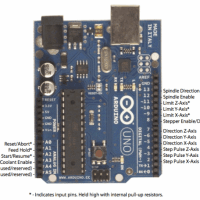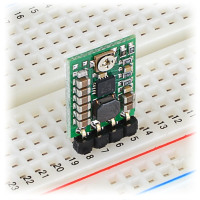Grbl is an opensource software that turns your Arduino development board into a full blown G-Code interpreter. Below the layout of the pins on the Arduino board. Each Stepper Motor Driver needs to be connected to the following pins: Stepper Driver Enable/Disable – Pin 8 Direction – Pin 5-7 depending on the Axis(X,Y,Z) Stepping Pulse … Read More →
Author Archives: Bertus Kruger
Cheap,quick and simple Step-Up / Step-Down Regulator
Pololu.com just introduced a tiny new Step-Up / Step-Down voltage regulator. Features Output voltage 2.5 – 8 V Input voltage 2.7 – 11.8 V Output current 500 mA to 1000mA 3 x 11 × 17 mm This will work very well in low-powered devices where you want to every bit of power a battery can offer. It is also … Read More →
Stepper Motors – Wiring up a Bipolar Stepper Motor
Bipolar stepper motors usually have 4 wires. That’s two wires per coil, hence the name Bi-Polar. Below are schematics of setups used with stepper motors. Steppers motor wires are usually labeled as A, B, C, D. A and C are connected, as well as B and D. You can generally determine which wires are connected using a multimeter,measuring … Read More →
Making Professional Looking Iliminated/LED Front Pannels
A few weeks ago I wrote about making some good looking front panels for your electronic projects… Since then I have found an even better way of making instrument panels look super professional. The process is very simple. Start with spray-painting high temperature spray paint on a piece of clear perspex or for that matter any color you want. Laser … Read More →
Arduino – Printing Float values to the Serial Port
I found that printing floating is a bit harder than it needs to be. The following is an example of how it can be done: Serial.println((float)(2.789),1); // This will print: “2.8” The 2.789 is the floating value that you want to print and the 1 after the comma is the number of decimal value you … Read More →
Sketchbot – From a Webcam Image to a drawing in sand. (Halfway around the world)
Google created a bunch of Chrome Web Lab experiments. Of the bunch the Sketchbot attracted my attention the most. I can just imagine a Sketshbot used for 3D printing… Here is a better description of how it works…
Sorting by color using Microcontrollers
Interesting how the human mind works. Take for example the video below… Somewhere in a crowded candy factory people make Skittles in all sorts of colors and then mix them up so people can enjoy some variety. … just to be sorted back to each color 5 minutes later. (I always loved the red once more!!!) So how does this … Read More →
Arduino – Quick And Easy Task Scheduler
This little Arduino library makes it easy to schedule repeating tasks with only a few lines of code. Features: Simplifies code Does not block the ‘loop’ function Runs a defined function(Task) you created at a set interval. Tasks can be delayed on start-up. Useful for when your task is dependent on other tasks starting first. Set the number … Read More →
OpenRover – DIY Ocean Exploring
OpenROV.Org is a community funded project that introduces people to Do-It-Yourself ocean exploring. Specs: Dimensions: 30cm x 20cm x 15cm Weight: 2.5kg Depth rating: ~100m Speed: 1m/sec Power: 8 onboard C batteries Run time: ~1.5 hours Design: Body construction: Laser cut acrylic Buoyancy: Inherently neutrally buoyant Propulsion: 3 brushless motors (2 horizontal thrusters, 1 vertical thruster) Tether: 1 single twisted … Read More →
Simple MySql data to XML with PHP
PHP can be used to create dynamic XML files that get data from your MySql database. Things to consider with the code below: There should be no spaces or open lines before “ All values between ‘[]’ brackets need to be replaced by your own settings. The three header lines will make sure your browser … Read More →









